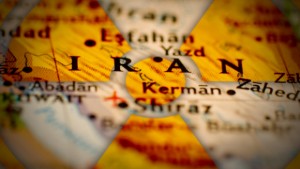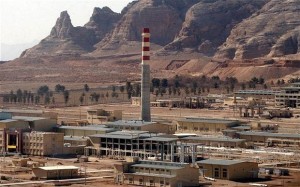By Wayne White
An excellent October 18 article, “The Myth of ‘Surgical Strikes’ on Iran“, by David Isenberg highlighted many of the conclusions of a sobering study by industrialist Khosrow Semnani on the potentially steep human cost of even a relatively selective attack against Iran’s diverse nuclear infrastructure. Semnani maintains that if the most important facilities [...]]]>By Wayne White
 An excellent October 18 article, “The Myth of ‘Surgical Strikes’ on Iran“, by David Isenberg highlighted many of the conclusions of a sobering study by industrialist Khosrow Semnani on the potentially steep human cost of even a relatively selective attack against Iran’s diverse nuclear infrastructure. Semnani maintains that if the most important facilities are hit during work shifts, on site casualties could be as high as 10,000. Additionally, since a few of the most important Iranian nuclear installations are located near population centers, toxic nuclear materials unleashed by the attacks could possibly inflict an even higher number of casualties on civilians. Yet, Semnani focused most of his attention on the the casualties stemming from attacks focused on just one critical slice of the nuclear sector, with less detailed references to other targets (which he notes could involve a grand total of “400″) that might be struck in an especially robust air campaign against Iran. Indeed, if the US in particular decided to carry out such attacks, some detail on the potential — in fact likely — impact far beyond Iran’s most high-profile nuclear facilities and their immediate surroundings needs to be added to this picture to gain a full appreciation of the extent of potential Iranian casualties.
An excellent October 18 article, “The Myth of ‘Surgical Strikes’ on Iran“, by David Isenberg highlighted many of the conclusions of a sobering study by industrialist Khosrow Semnani on the potentially steep human cost of even a relatively selective attack against Iran’s diverse nuclear infrastructure. Semnani maintains that if the most important facilities are hit during work shifts, on site casualties could be as high as 10,000. Additionally, since a few of the most important Iranian nuclear installations are located near population centers, toxic nuclear materials unleashed by the attacks could possibly inflict an even higher number of casualties on civilians. Yet, Semnani focused most of his attention on the the casualties stemming from attacks focused on just one critical slice of the nuclear sector, with less detailed references to other targets (which he notes could involve a grand total of “400″) that might be struck in an especially robust air campaign against Iran. Indeed, if the US in particular decided to carry out such attacks, some detail on the potential — in fact likely — impact far beyond Iran’s most high-profile nuclear facilities and their immediate surroundings needs to be added to this picture to gain a full appreciation of the extent of potential Iranian casualties.Yet, as opposed to the relatively limited scope of any Israeli attack dictated by the extreme range involved and the smaller aerial strike package that could be deployed (in terms of extending casualties beyond those outlined in the article and Semnani’s study, both nuclear and civilian), many expect that any US attack on Iran’s nuclear capabilities would be far more comprehensive. Specifically, the US would be able to muster a much larger force of aircraft (and cruise missiles) with which to operate, and at far closer range. In order to clear paths to the targets cited, I am among those observers who anticipate in such a scenario waves of parallel US strikes against Iranian military communications, land-based anti-ship missile sites, any Iranian naval forces that could pose a potential threat to US warships operating offshore (as well as the Strait of Hormuz more generally), Iranian air force aircraft and bases, as well as Iranian anti-aircraft defenses. Finally, there might also be an attempt to take out as much of Iran’s ballistic missile testing, manufacturing, storage, and basing assets as possible. After all, Iran’s ambitious missile program relates directly to Iran’s ability to retaliate and might be associated with any eventual Iranian intent to weaponize and deliver nuclear weapons.
In other words, not only could a US assault (much as outlined in 2006 by the US military in its briefings of the Bush Administration, including potentially several thousand missions by combat aircraft) extend far beyond anything any reasonable individual could possibly regard as ”surgical,” the overall attack probably would more closely resemble a flat-out war. And, naturally, in the context of such a considerably more dire scenario, those attempting to estimate potential casualties (nuclear industry workers, civilians, as well as Iranian military personnel) would be advised to hike them up quite a bit higher.
- Wayne White is a Policy Expert with Washington’s Middle East Policy Council. He was formerly the Deputy Director of the State Department’s Bureau of Intelligence and Research’s Office of Analysis for the Near East and South Asia (INR/NESA) and senior regional analyst. Find his author archive here.
I’ve been meaning to write about this report on the multifold human costs of militarily striking Iran’s nuclear facilities and am happy to find that it’s already been noted by Golnaz Esfandiari as well as Gordon Lubold, among others. (Marsha Cohen’s well-read Lobe Log post on [...]]]>
 I’ve been meaning to write about this report on the multifold human costs of militarily striking Iran’s nuclear facilities and am happy to find that it’s already been noted by Golnaz Esfandiari as well as Gordon Lubold, among others. (Marsha Cohen’s well-read Lobe Log post on the same topic was the closest thing to such a study that I’ve come across so far.) “The Ayatollah’s Nuclear Gamble” is sponsored by Utah’s Hinckley Institute of Politics and was authored by Khosrow B. Semnani, an Iranian-American engineer by training and philanthropist. It will be featured this week at a joint event by the Woodrow Wilson Center and the Iran Task Force at the Atlantic Council. With the study Semnani endeavors to scientifically prove something which seems obvious: attacking nuclear facilities in Iran could have devastating effects on possibly hundreds of thousands of Iranians who would be exposed to highly toxic chemical plumes and even radioactive fallout. Case studies were conducted on the Iranian cities of Isfahan, Natanz, Arak, and Bushehr. In Isfahan, a military strike on the nuclear facility there “could be compared to the 1984 Bhopal industrial accident at the Union Carbide plant in India”:
I’ve been meaning to write about this report on the multifold human costs of militarily striking Iran’s nuclear facilities and am happy to find that it’s already been noted by Golnaz Esfandiari as well as Gordon Lubold, among others. (Marsha Cohen’s well-read Lobe Log post on the same topic was the closest thing to such a study that I’ve come across so far.) “The Ayatollah’s Nuclear Gamble” is sponsored by Utah’s Hinckley Institute of Politics and was authored by Khosrow B. Semnani, an Iranian-American engineer by training and philanthropist. It will be featured this week at a joint event by the Woodrow Wilson Center and the Iran Task Force at the Atlantic Council. With the study Semnani endeavors to scientifically prove something which seems obvious: attacking nuclear facilities in Iran could have devastating effects on possibly hundreds of thousands of Iranians who would be exposed to highly toxic chemical plumes and even radioactive fallout. Case studies were conducted on the Iranian cities of Isfahan, Natanz, Arak, and Bushehr. In Isfahan, a military strike on the nuclear facility there “could be compared to the 1984 Bhopal industrial accident at the Union Carbide plant in India”:
In that accident, the release of 42 metric tons (47 U.S. tons) of methyl isocyanate turned the city of Bhopal into a gas chamber. Estimates of deaths have ranged from 3,800 to 15,000. The casualties went well beyond the fatalities: More than 500,000 victims received compensation for exposure to fumes.
The environmental consequences would also be wide-ranging:
With the high likelihood of soluble uranium compounds permeating into the groundwater, strikes would wreak havoc on Isfahan’s environmental resources and agriculture. The Markazi water basin, one of six main catchment areas, which covers half the country (52%), provides slightly less than one-third of Iran’s total renewable water (29%) (Figure 26). According to the Food and Agriculture Organization (FAO), the groundwater discharge in the basin from approximately 155,000 wells, 22,000 channels and 13,500 springs is the primary water source for agricultural and residential uses.106 It is almost certain that the contamination of groundwater as a result of strikes would damage this important fresh-water source.
The report also touches on the unintended consequences of militarily striking Iran, such as a “short or prolonged regional war” and explains, as reputable analysts have, why the Israeli strike on Iraq’s Osirak facility is a “false analogy”:
The Osirak analogy is the fantasy that there will be no blowback from strikes against Iran’s nuclear facilities. It discounts the complexity, severity, scale, consequences, and casualties such an operation would entail. Iran’s nuclear program is not an empty shell, nor is it a single remote target. The facilities in Iran are fully operational, they contain thousands of personnel, they are located near major population centers, they are heavily constructed and fortified, and thus difficult to destroy. They contain tons of highly toxic chemical and radioactive material. To grasp the political and psychological impact of the strikes, what our estimates suggest is that the potential civilian casualties Iran would suffer as a result of a strike — in the first day — could exceed the 6,731 Palestinians and 1,083 Israeli’s reported killed in the Israeli-Palestinian conflict over the past decade. The total number of fatalities in the 1981 Osirak raid was 10 Iraqis and one French civilian, Damien Chaussepied.
According to Greg Thielmann of the Arms Control Association, the report makes a “valuable contribution to “colorizing” the bloodless discussions of the “military option.” Thielmann, who formerly worked on assessments of ballistic missile threats at the State Department’s intelligence bureau, told Lobe Log that he had not seen “a more serious look at the medical consequences for the Iranian population” than provided by this report.
While Thielmann calls the report an “impressive effort”, he also offered criticism. “I take strong exception to the author’s introductory assertion that diplomacy with the Islamic Republic “requires a willful act of self-deception,” and that regime change is the only way to achieve an acceptable resolution to the challenges of Iran’s nuclear program,” he said.
Thielmann was also “surprised” that the strike scenario analyzed in the study includes the Bushehr facility, “which is of much less proliferation concern than the other nuclear facilities mentioned, and which, because of the extensive use of Russian personnel in operating the reactor there, would carry high political costs to attack. ”
“Such an attack would also violate Additional Protocol I of the 1949 Geneva Conventions,” said Thielmann, who provided the following excerpt from Article 56 of the 1977 Additional Protocol I:
1. Works and installations containing dangerous forces, namely dams, dykes and nuclear electrical generating stations, shall not be made the object of attack, even where these objects are military objectives, if such attack may cause the release of dangerous forces and consequent severe losses among the civilian population. Other military objectives located at or in the vicinity of these works or installations shall not be made the object of attack if such attack may cause the release of dangerous forces from the works or installations and consequent severe losses among the civilian population.
It will be interesting to see whether the report gets mainstream media attention following the Wilson Center event and if it will spark further examination of this integral — but otherwise barely mentioned — aspect of using the “military option” on Iran.
]]>